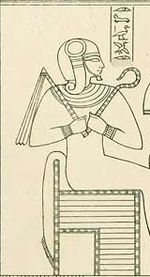Ahmose Sapair
| Ahmose Sapair in hieroglyphics | ||||||||
|---|---|---|---|---|---|---|---|---|
|
||||||||
Ahmose Sapair Jˁḥ ms S3 p3jr |
||||||||
| Ahmose Sapair ( tomb of Amenmesse ) with youth lock | ||||||||
Ahmose Sapair was an ancient Egyptian king's son who was born in the late 17th or early 18th dynasty .
background
family
In Egyptology the naming of parents is controversial. Seqenenre , Kamose or Ahmose I. come into consideration as possible fathers . The assignment of the mother (probably Ahmose Nefertari ) and all siblings is just as problematic . Ahmose Sapair is clearly documented as the brother of Amenophis I and Ahmose Meritamun II , daughter of Ahmose Nefertari.
Ahmose Sapair was briefly married to Ahmose Meritamun II, before Ahmose Meritamun II later became the " Great Royal Wife " of Amenhotep I due to the death of Ahmose Sapair .
Cult of Ahmose Sapair
During the excavations of the Egyptologist Herbert E. Winlock in Dra Abu el-Naga , fragments of an inscription with Ahmose Sapair's name were found on a pyramidion . The exact assignment of the structure as a Kamose or Ahmose Sapair pyramid remains unclear . The special spelling of the moon hieroglyph is striking and eye-catching : the ancient Egyptian word Iah ( moon ) was written with the mirror-inverted crescent moon as a barque and a point in the crescent moon. Only between the 17th and 22nd year of reign did Ahmose I introduce the later traditional representation.
Due to this special shape, construction of the pyramidion and the associated pyramid can be dated before the 22nd year of Ahmose I's reign. However, it remains open whether the completion falls during the time of office of Ahmose I, since the end of the 17th dynasty is also an option. In this context, the Egyptologist Claude Vandersleyen confirms Winlock's remarks that later restorations of the associated pyramid fit the environment of the posthumous veneration of Ahmose Sapair. He therefore sets the pyramid to be erected at the end of the 17th dynasty, as the surrounding private graves in the eastern apron have the same chronological framework.
Kamose and Ahmose Sapair received numerous posthumous honors in the New Kingdom . Ahmose Sapair is also represented on at least one object of the 21st dynasty . In the Abbott Papyrus , Ahmose Sapair is referred to as "King's son" as well as "King". In the ancestral gallery in the grave of Amenmesse ( KV10 ), however, his name is not in a royal cartouche . Vandersleyen therefore sees Ahmose Sapair as a son of the Seqenenre who died young.
The Egyptologist Chris Bennett argues similarly, who sees Ahmose Sapair as an adult son of the Seqenenre who, however, perished early. Bennett suspects that he was the father of Thutmosis I as the reason for Ahmose Sapair's veneration in the following years , but without being able to provide contemporary evidence for this.
The statue of Prince Ahmose is currently (June 2016) on display in the Louvre in Paris .
See also
literature
- Chris Bennett: Thutmose I. and Ahmes-Sapair. In: Göttinger Miscellen . No. 141, Göttingen 1994, pp. 35-38.
- Daniel Polz : The beginning of the New Kingdom. To the history of a turning point. de Gruyter, Berlin 2007, ISBN 3-11-019347-7 .
- Constantin Emil Sander-Hansen: Amun's divine wife. Munksgaard, København 1940.
- Claude Vandersleyen: Iahmès Sapaïr: Fils de Séqénenré Djéhouty-Aa (17th dynasty) et la statue du Musée du Louvre E 15682.Saffran , Brussels 2005, ISBN 2-87457-002-8 .
Web links
- Statuette of Ahmose Sapair: Justified on the throne
- Description of the mummies by Ahmose Sapair
- Mummy paintings by Ahmose Sapair
Individual evidence
- ^ Günter Roeder: Hermopolis 1929 - 1939: excavations of the German Hermopolis expedition in Hermopolis, Upper Egypt . Gerstenberg, Hildesheim 1940, p. 39; Constantin Emil Sander-Hansen: Amun's divine wife . Munksgaard, København 1940, p. 6.
-
↑

| personal data | |
|---|---|
| SURNAME | Ahmose Sapair |
| BRIEF DESCRIPTION | Consort of Ahmose Merit-Amun |
| DATE OF BIRTH | 16th century BC Chr. |
| DATE OF DEATH | 16th century BC Chr. |

